Philippopolis (Plovdiv)
Q459Philippopolis (Greek Φιλιππούπολις): city in Thrace, founded by king Philip of Macedonia; important town in the Roman province of Thrace; border town in the Byzantine Empire.
Origins

Philippopolis was founded by and named after king Philip II of Macedonia in 342/341 BCE, after he had captured a fortified settlement of the Thracian Bessi on the plain of the Upper Hebros (modern Maritsa). The site already was a node in a network of roads. Philip's own interest must have been the road to the Nestus valley and Macedonia in the southwest. Along the Hebros, one could travel to the Thracian Odrysae in the southeast and to Byzantium and Perinthus; it was possible to travel eastward the Greek ports of Apollonia and Mesambria on the Black Sea; crossing the Balkan Mountain Range, one would reach the plain of the Lower Danube; and finally, one could go to the northwest, to the Thracian Serdi, whose main settlement Serdica was to become the city of Sofia.
This was a great site to build a city, which Philip named it after himself. (His son Alexander would at the same time build another town and name it after himself as well.) The ancient town taken over and refounded by Philip can still be recognized in Plovdiv's citadel and immediately south of it, where the streets were arranged in the usual gridiron. There was atemple of Philip's favorite god, Apollo.`In the new city, he was usually considered to be the same as the Thracian "horseman god" and called Apollo Kendresenos.
However, just like Serdica, which was also part of the Macedonian kingdom during the reigns of Philip and Alexander, Philippopolis was lost to the Thracians again. This may have happened during the reign of Lysimachus (r.323-281) or in the crisis years after the Galatian attacks (279 BCE). In any case, Philippopolis was reconquered by Philip V of Macedonia in 183 BCE.note
Roman city

Soon, it was lost again to the Odrysan Thracians,note who made it the residence of their kings. They may have renamed it Eumolpia, although the evidence is rather late.note In 72 BCE, during the Third Mithridatic War, the Roman general Marcus Terentius Varro Lucullus took the city,note which was looted but - for the time being - remained under control of the Odrysae. During the reign of the emperor Claudius, however, the Odrysan kingdom was added to the Roman Empire and Philippopolis became a Roman town (45 CE).
The existing roads were improved and Philippopolis soon expanded to cover three hills and was therefore, nicknamed Trimontium, "three hills town". note It was an important city, inhabited by people with names that document origins in Thrace, Greece, Italy, and Asia Minor. A synagogue is evidence for another minority and contributes to the impression that Philippopolis was a cosmopolitan city.
The second and early third century were the city's "golden age". It was certainly the largest city in Thrace (although Perinthus was its capital).This coincides with the period in which Philippopolis minted its own coins, from the reign of Domitian (r.81-96) until the reign of Heliogabalus (r.218-222). Several monuments that can still be seen in Plovdiv date back to the late first to third century.

- The Forum area, dating back to the first century, with a bouleuterion/odeon, a treasury, a library, and of course shops
- The theater, built during the reign of Trajan (r.98-117) in the saddle between two of the hills, with a capacity of 6,000 visitors
- The stadium, with a length of 240 meters and capacity of 30,000 visitors
- City walls during the reign of Marcus Aurelius, including the East Gate, surrounding an area of almost eighty hectares
Writing in the 160s, Lucian makes two deities, Heracles and Hermes, praise Philippopolis: situated between the Haemus (Balkan) and Rhodope Mountains, its plain is delightful, the three hills are beautiful, while the settlement itself is the greatest and noblest in Thrace, with a splendor that is conspicuous even from a distance.note Lucian adds that the city had become the residence of false philosophers.
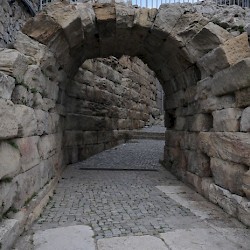 Plovdiv, Theater |
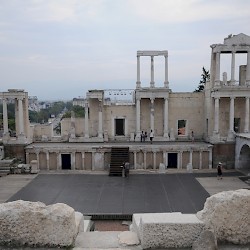 Plovdiv, Theater, stage |
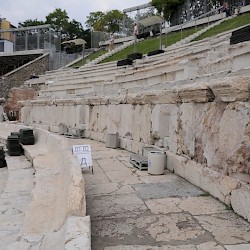 Plovdiv, Theater, seats |
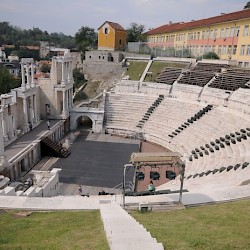 Plovdiv, Theater |
 Plovdiv, Bouleuterion/Odeon |
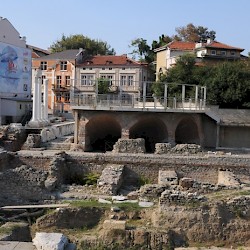 Plovdiv, Forum-Odeon area |
 Plovdiv, Postoffice Excavations |
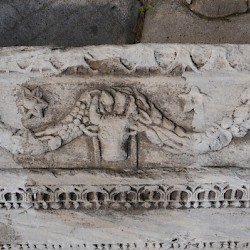 Plovdiv, East Gate, decoration |
Late Antiquity

Christianity is known from Philippopolis from the third century on. During the great persecutions at the beginnning of the fourth century, thirty-seven Christians from the city were tortured to death. Later, when Christianity had become a permitted religion, one of the churches was built in the former Temple of Apollo. The city would soon be the main ecclesiastical center (metropolis) of Thrace. In 340, a council took place in the town.
The region of Philippopolis suffered from several barbarian raids. The first and most shocking was in 251, when a German leader named Cniva assembled a coalition of tribes and crossed the Danube. Having defeated the Roman army near Augusta Traiana (Stara Zagora), they marched on Philippopolis, where the governor of Thrace, Titus Julius Priscus, had proclaimed himself emperor. Cniva captured the city and sacked it.note On his return to the Danube, a reorganized Roman army, led by the official emperor Decius, defeated the invaders (battle of Abritus). The emperor was killed in action.
This was not the last invasion. The emperor Valens had to repel another tribal federation, which would later be called Visigoths, from Thrace in the years 367-369. They returned a couple of years later and destroyed Valens' army at Hadrianopel (378). Another emperor was killed in action. Until 390/391. Thrace was essentially a war zone and Philippopolis must have suffered.
The Huns attacked in 443 and 551, and the Avars in 586. Reconstruction works were often necessary and the Forum area was used to find building materials. When a statue had to be erected for a general named Basiliscus (who was to be emperor in 475), an older inscription was recycled.
Philippopolis had already been promoted to the rank of provincial capital of one of the Thracian provinces by the emperor Diocletian (r.284-305) and remained an important city in the Byzantine Empire. The wall was repaired on several occasions,note especially after the first Bulgars had arrived south of the Balkan Mountains and Philippopolis became a frontier city.
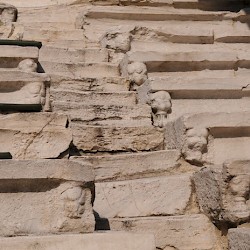 Plovdiv, Stadium |
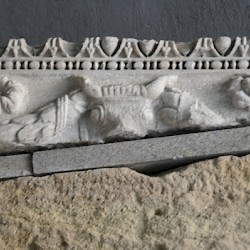 Plovdiv, Stadium |
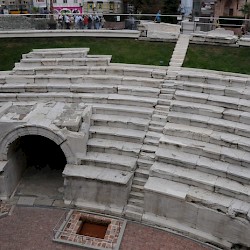 Plovdiv, Stadium |
 Plovdiv, Stadium |